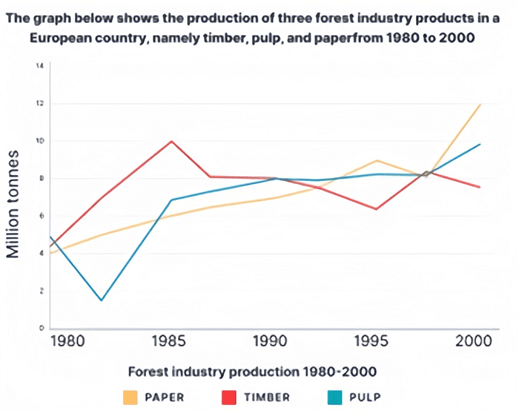5+ The graph below shows the production of three forest industry products in a European
The graph below shows the production of three forest industry products in a European country, namely timber, pulp, and paper from 1980 to 2000. Summarise the information by selecting and reporting the main features, and make comparisons where relevant. Write at least 150 words hay nhất giúp bạn có thêm tài liệu tham khảo để viết bài luận bằng Tiếng Anh hay hơn.
- The graph below shows the production of three forest industry products in a European (mẫu 1)
- The graph below shows the production of three forest industry products in a European (mẫu 2)
- The graph below shows the production of three forest industry products in a European (mẫu 3)
- The graph below shows the production of three forest industry products in a European (mẫu 4)
5+ The graph below shows the production of three forest industry products in a European
Đề bài: The graph below shows the production of three forest industry products in a European country, namely timber, pulp, and paper from 1980 to 2000. Summarise the information by selecting and reporting the main features, and make comparisons where relevant. Write at least 150 words
The graph below shows the production of three forest industry products in a European - mẫu 1
The graph below shows the production of three forest industry products in a European country, namely timber, pulp, and paper, from 1980 to 2000.
Overall, while all three categories fluctuated wildly throughout the period, they ultimately increased substantially.
In 1980, even though pulp had the highest production initially (roughly 5.5 million tons), it plummeted to just over 2 million tons and was immediately overtaken by timber in the following years. From 1982 to 1985, both timber and pulp had similar increasing trends, rising sharply from 6.5 to 10 and 2.2 to 6.5 million tons, respectively. From 1985 to 1990, pulp’s figure kept growing at a slower rate while timber dipped to 8.0 million tons in 1987 and remained there till 1990. Paper consistently grew from 4.0 to 6.5 million tons during this time frame.
For the remaining period, timber declined to around 6.2 million tons before bouncing back to 8.0 in 1997 and slightly decreased to 7.8 in 2000, ultimately finishing last. In contrast, despite a slight dip in 1997, the paper almost doubled its 1990 figure and reached first place in 2000. In the same period, pulp gradually rose from 8.0 to approximately 10.0 million tons.
The graph below shows the production of three forest industry products in a European - mẫu 2
The line chart demonstrates the production trends of three forest industry products - timber, pulp and paper - in a European country over a 20-year period, from 1980 to 2000.
Overall, it can be observed that all three categories had fluctuated throughout the period. Pulp and paper, in particular, experienced an upward trend, while timber saw a downward trend.
In terms of pulp and paper production, pulp was marginally higher than paper in 1980, with nearly 6 million tonnes and 4 million tonnes, respectively. Following a sharp decline, pulp production began to recover in 1985, climbing from 7 million tonnes to 10 million tonnes by the end of the period. Similarly, paper production rose steadily until a slight fallback in 1995, and then increased rapidly, peaking at 12 million tonnes in 2000.
Regarding timber, the production started at 5 million tonnes in 1980 and rose sharply to 10 million tonnes in 1985. However, over the following 15 years, the production figure saw a gradual decrease and eventually reached nearly 8 million tonnes at the end of the period.
The graph below shows the production of three forest industry products in a European - mẫu 3
The given graph depicts the production of wood pulp, timber, and paper in a European country between 1980 and 2000. Overall, the growth in paper production was substantial and steady throughout the period, while the quantity of wood pulp increased moderately with some disruptions. Timber, on the other hand, was the only product to have such irregularities and experienced significant fluctuations.
In 1980, paper production began at 4 million tonnes, which climbed steadily to 9 million tonnes before experiencing a slight dip to 8 million tonnes in 1997-98. The quantity then recovered and reached its peak at 12 million tonnes in 2000.
Wood pulp started with the highest production of the three commodities, with 6 million tonnes, but dropped to about 3.6 million tonnes by 1983. It immediately rose again and tripled the previous level in 1985. However, there was not much growth in the following period, and the production remained between 7-10 million tonnes.
Between 1980 and 1985, the production of timber increased dramatically, from 5 million tonnes to 10 million tonnes, before declining to just over 6 million tonnes until 1995. Production grew once again to 8 million tonnes in the final five years of the era before rapidly falling off once more.
The graph below shows the production of three forest industry products in a European - mẫu 4
The provided graph illustrates the production trends of timber, pulp, and paper in a European country from 1980 to 2000.
Throughout the entire period, all three categories experienced notable fluctuations, yet collectively demonstrated substantial overall growth.
The initial production of pulp slightly surpassed that of paper in 1980, with approximately 6 million tonnes for pulp and 4 million tonnes for paper. Subsequently, pulp experienced a significant decline to under 2 million tonnes in 1982 before a recovery to about 7 million tonnes in 1985 and then a substantial 10 million tonnes by the conclusion of the period. Conversely, paper production displayed a consistent increase from 4 to a high of approximately 9 million tonnes in 1995, momentarily slowing in 1995, before surging rapidly and reaching its pinnacle at 12 million tonnes by 2000.
In contrast, timber production commenced at 5 million tonnes in 1980, swiftly escalating to 10 million tonnes by 1985. However, over the ensuing 10 years, timber production exhibited a gradual decline to hit a low of about 6 million tonnes in 1995. Then, this figure rebounded before dropping again to under 8 million tonnes by 2000, concluding in the lowest position.
Xem thêm các bài luận Tiếng Anh hay khác:
Đã có app VietJack trên điện thoại, giải bài tập SGK, SBT Soạn văn, Văn mẫu, Thi online, Bài giảng....miễn phí. Tải ngay ứng dụng trên Android và iOS.
Theo dõi chúng tôi miễn phí trên mạng xã hội facebook và youtube:Nếu thấy hay, hãy động viên và chia sẻ nhé! Các bình luận không phù hợp với nội quy bình luận trang web sẽ bị cấm bình luận vĩnh viễn.
- Đề thi lớp 1 (các môn học)
- Đề thi lớp 2 (các môn học)
- Đề thi lớp 3 (các môn học)
- Đề thi lớp 4 (các môn học)
- Đề thi lớp 5 (các môn học)
- Đề thi lớp 6 (các môn học)
- Đề thi lớp 7 (các môn học)
- Đề thi lớp 8 (các môn học)
- Đề thi lớp 9 (các môn học)
- Đề thi lớp 10 (các môn học)
- Đề thi lớp 11 (các môn học)
- Đề thi lớp 12 (các môn học)
- Giáo án lớp 1 (các môn học)
- Giáo án lớp 2 (các môn học)
- Giáo án lớp 3 (các môn học)
- Giáo án lớp 4 (các môn học)
- Giáo án lớp 5 (các môn học)
- Giáo án lớp 6 (các môn học)
- Giáo án lớp 7 (các môn học)
- Giáo án lớp 8 (các môn học)
- Giáo án lớp 9 (các môn học)
- Giáo án lớp 10 (các môn học)
- Giáo án lớp 11 (các môn học)
- Giáo án lớp 12 (các môn học)






 Giải bài tập SGK & SBT
Giải bài tập SGK & SBT
 Tài liệu giáo viên
Tài liệu giáo viên
 Sách
Sách
 Khóa học
Khóa học
 Thi online
Thi online
 Hỏi đáp
Hỏi đáp

